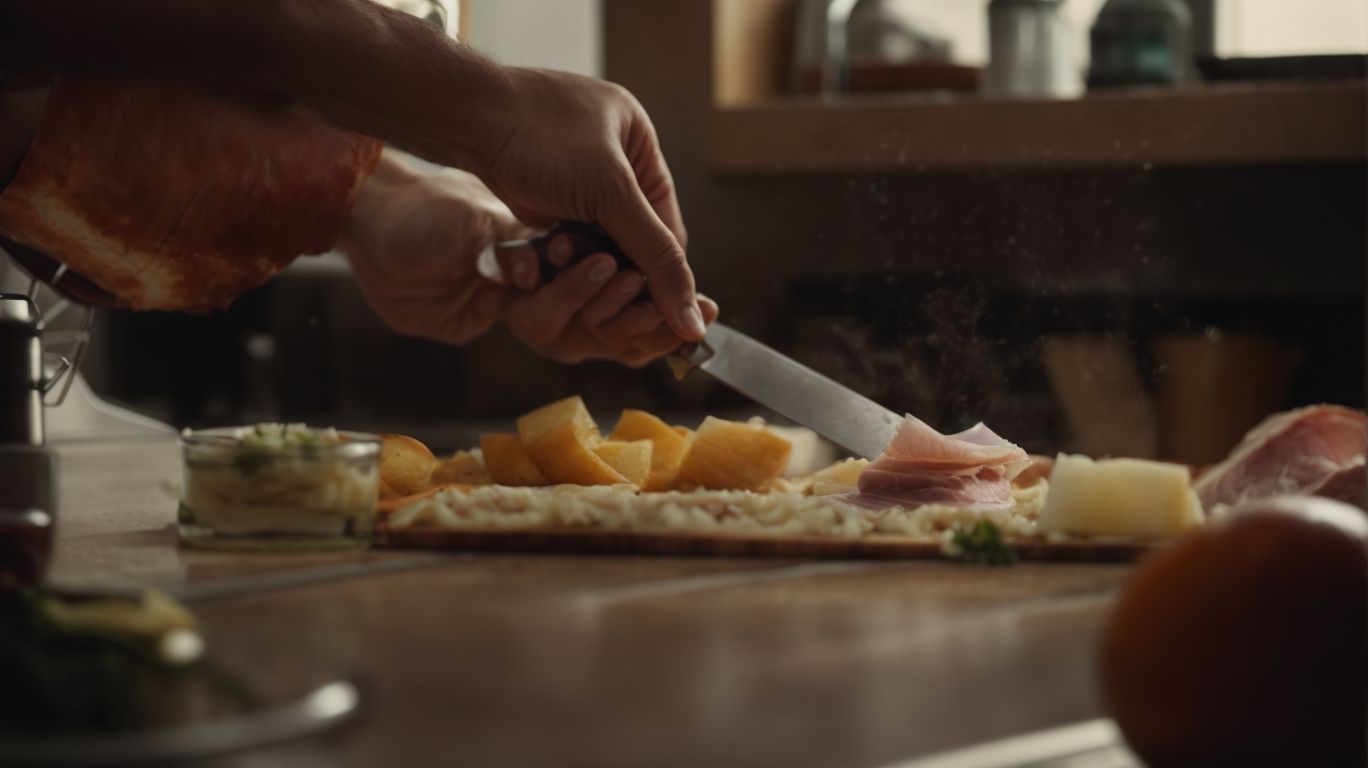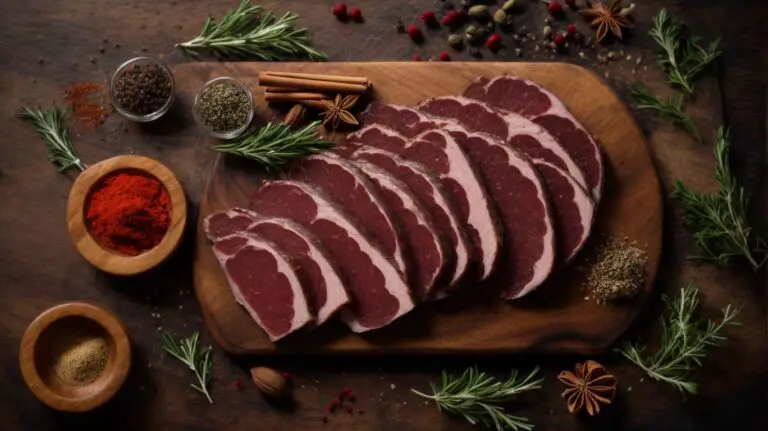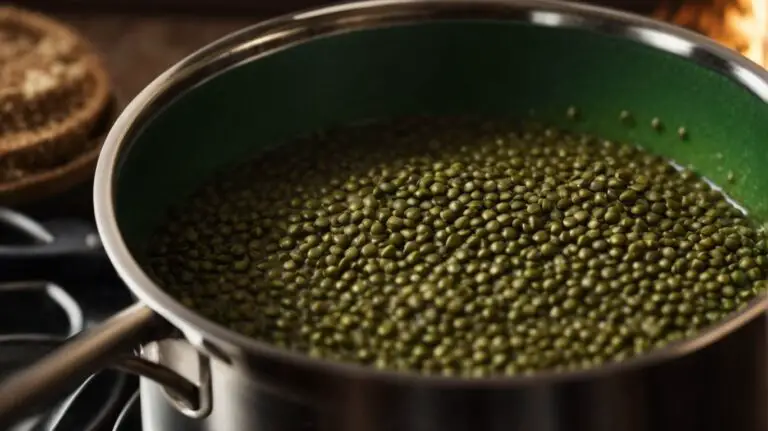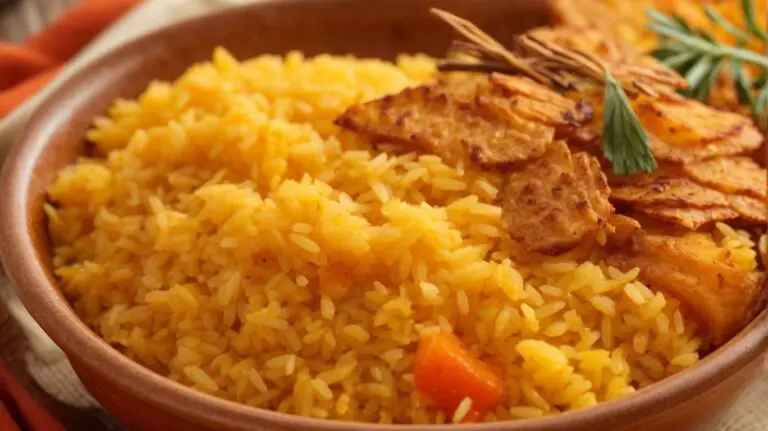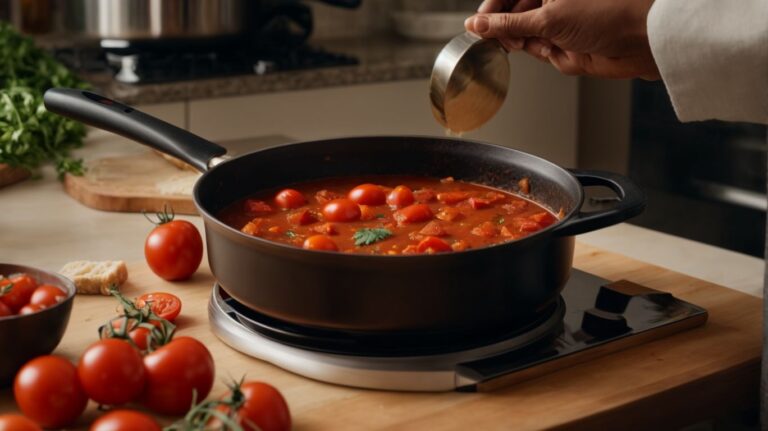How to Cook Ham?
Are you looking to master the art of cooking ham? Look no further!
In this comprehensive guide, we will cover everything you need to know about choosing, preparing, cooking, and serving the perfect ham.
From different types of ham to various cooking methods, we’ve got you covered.
Whether you’re a seasoned chef or a beginner in the kitchen, our tips and tricks will help you cook the perfect ham every time.
Let’s get started! #ham #cooking #recipes #foodblogging #tipsandtricks
Key Takeaways:
What is Ham?
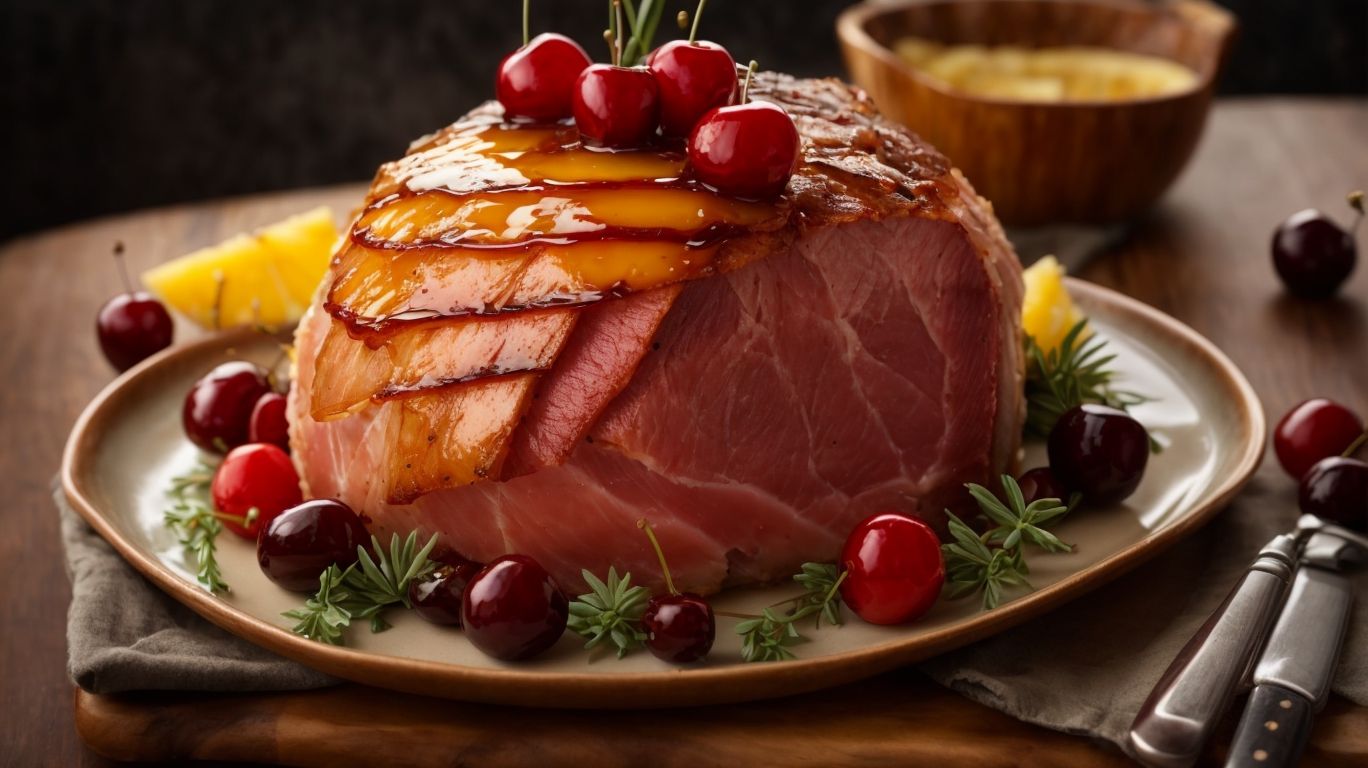
Credits: Poormet.Com – Eugene Allen
Ham is a type of meat that comes from the leg or hind portion of a pig, often cured or smoked for flavor and preservation.
Historically, ham has been a staple in many cultures due to its long shelf life and rich taste. The preparation of ham can vary widely; some hams are dry-cured, others wet-cured, and some are even honey-glazed for a sweet finish.
Country ham is a popular variation typically dry-cured with salt and spices, while prosciutto is a type of Italian ham that is thinly sliced and air-dried for a distinct flavor. Cooking techniques for ham include baking, boiling, or even grilling, each method enhancing the unique flavors of this versatile meat.
Choosing the Right Ham
Selecting the perfect ham involves considering factors like bone-in or boneless, spiral cut or whole, and the desired flavor profile for the dish.
Regarding choosing between bone-in or boneless hams, bone-in options are often preferred for their enhanced flavor and juiciness, while boneless hams offer convenience during slicing and serving.
The decision between spiral cut or whole hams depends on the presentation style and ease of carving. Spiral cut hams are pre-sliced for effortless serving, making them ideal for gatherings or events, while whole hams allow for custom slicing based on personal preferences.
Flavor profiles play a crucial role in selecting the right ham, with options ranging from traditional smoked hams, honey-glazed varieties, to exotic options like prosciutto or serrano ham, each offering unique taste experiences.
Types of Ham
The different types of ham include bone-in ham, boneless ham, and spiral-cut ham, each offering unique textures and flavors for various culinary creations.
Bone-in ham, also known as whole ham, is typically large and has the bone running through the center, which adds flavor during cooking. This type of ham is usually best for roasting or slow cooking, allowing the meat to become tender and juicy.
Boneless ham, on the other hand, is easier to slice and serves perfectly for sandwiches or salads, favored for its convenience.
Spiral-cut ham is pre-sliced in a spiral pattern, making it effortless to serve and enjoy, often glazed for a sweet and savory taste.
Factors to Consider When Choosing Ham
When selecting ham, factors such as the desired flavor intensity, texture preferences, and the occasion for serving the dish should be taken into account.
Ham varieties can range from the rich and savory taste of country ham to the mild and sweet notes of honey-glazed ham. The texture of ham can vary from tender and moist to firm and chewy, adding depth to your dish. Consider the occasion – a festive gathering may call for a smoky ham with bold flavors, while a casual brunch could be complemented by a delicate, thinly sliced ham. It’s crucial to purchase ham from reputable sources, like local butcher shops, to ensure quality and flavor authenticity.
Preparing Ham for Cooking

Credits: Poormet.Com – Jacob Davis
Preparing ham for cooking involves essential steps like thawing frozen ham to ensure even cooking and trimming excess fat for optimal flavor and texture.
When thawing frozen ham, it’s recommended to plan ahead and defrost it in the refrigerator to prevent any potential bacterial growth. Allow approximately 24 hours for every 4-5 pounds of ham, ensuring it’s placed on a tray to catch any juices. Remember, never thaw ham at room temperature as this can lead to unsafe food practices.
As you trim the excess fat from the ham, notice that leaving a thin layer can add flavor and prevent the meat from drying out during cooking. Removing any thick outer skin or rind will also enhance the absorption of flavorful marinades or glazes, ensuring a more delicious end result.
Thawing Frozen Ham
Thawing frozen ham safely is crucial to prevent bacterial growth and ensure that the meat cooks evenly when placed in the oven.
Regarding thawing frozen ham, the best method is to plan ahead and allow enough time for the process. Defrosting ham in the refrigerator is the safest approach, as it maintains a consistent cold temperature, preventing any rapid growth of harmful bacteria. As a general rule of thumb, it can take around 24 hours for every 5 pounds of ham to thaw in the fridge. For larger cuts, such as a whole ham, it may require several days.
Alternatively, you can opt for the cold water method for quicker thawing. Submerge the ham in a leak-proof plastic bag in cold water, changing the water every 30 minutes. This method is faster than the refrigerator option, typically taking about 30 minutes per pound of ham to thaw. It requires more attention to ensure the water stays cold to prevent bacteria growth.
Trimming the Fat
Trimming excess fat from ham not only enhances the meat’s flavor and texture but also helps in achieving even cooking and caramelization during the roasting process.
By removing the excess fat, you not only reduce the overall calorie and fat content of the dish but also create a more visually appealing presentation.
Removing the fat allows the flavors of the seasonings and glazes to penetrate the meat more effectively, resulting in a more flavorful end product.
Trimming the fat helps prevent flare-ups in your oven or grill, reducing the risk of burning and ensuring a more consistent cooking process.
When trimming fat, it’s essential to use a sharp knife and follow the natural contours of the meat to preserve its shape and integrity.
Cooking Methods for Ham
Ham can be cooked using various methods including baking, glazing, grilling, slow-cooking, and smoking, each imparting distinct flavors and textures to the dish.
When opting for baking, the ham is typically placed in the oven at a moderate temperature which allows for a nice, even cook throughout. This method often calls for basting to keep the meat moist, and you can create a delicious crust with a brown sugar glaze.
On the other hand, grilling provides a charred exterior with a smoky essence. Adding a sweet and tangy barbecue sauce during the grilling process can elevate the taste profile.
Slow-cooking involves simmering the ham gently over a long duration, resulting in tender, succulent meat. A honey mustard glaze can infuse the ham with flavor as it slowly cooks.
When smoking ham, the meat absorbs the rich flavors of the wood, creating a deliciously smoky taste. A cracked black pepper rub can add complexity to the overall flavor profile.
Baking Ham
Baking ham in the oven is a popular method that involves roasting at a specific temperature to achieve a moist, tender texture and optimal flavor.
Preheat your oven to 325°F to ensure even cooking and succulent results. Before placing the ham in the oven, consider scoring the surface in a crisscross pattern to allow flavors to penetrate better. For added moisture and tenderness, you can baste the ham with a flavorful glaze as it cooks. Cover the ham loosely with foil during the initial stages of cooking to prevent the outer layer from drying out, then remove the foil towards the end to achieve a golden, caramelized finish.
Glazing Ham
Glazing ham with a sweet and savory mixture like brown sugar, mustard, pineapple juice, or orange juice enhances its flavor profile, resulting in a delicious and festive dish.
The key to perfecting a glazed ham lies in the balance of sweetness and tanginess, creating a caramelized crust that seals in the juices. For a classic brown sugar glaze, combine brown sugar, honey, Dijon mustard, and cloves. Alternatively, a tangy mustard glaze can be made by mixing grainy mustard, maple syrup, and apple cider vinegar. Other flavorful options include a fruity glaze using apricot preserves or a spicy glaze with a hint of cayenne pepper for an extra kick. Experimenting with different combinations is the ultimate way to discover your favorite glaze for a memorable holiday meal.
Grilling Ham
Grilling ham adds a smoky charred flavor that is perfect for special occasions, creating a delicious and visually appealing dish for gatherings.
When grilling ham, it’s essential to select the right cut; a bone-in ham offers more flavor and juiciness than boneless options. To enhance the taste experience, consider using a rub or marinade – a mix of honey, mustard, and herbs can create a delightful contrast to the smoky notes from the grill.
For optimal grilling results, preheat your grill to medium-high heat and place the ham on the grate, allowing it to cook evenly. Basting with the marinade throughout the grilling process will help keep the meat moist.
Slow-Cooking Ham
Slow-cooking ham in a crock-pot or slow-cooker produces juicy, tender meat with a rich roasted flavor, making it a convenient and flavorful cooking method.
When preparing ham in a slow-cooker, the low and slow cooking process allows the meat to fully absorb the delicious seasonings, resulting in a mouthwatering dish that practically falls off the bone. A crock-pot ham recipe often involves simple ingredients like brown sugar, honey, cloves, or mustard, all of which infuse the ham with a delightful blend of sweet and savory flavors. This method is ideal for busy days when you can set it and forget it, coming home to a fragrant house and a delectable meal ready to enjoy.
Smoking Ham
Smoking ham imparts a distinct smoky flavor to the meat, resulting in succulent and flavorful dishes that can be enjoyed freshly cooked or reheated for later meals.
When smoking ham, the choice of wood chips used greatly influences the flavor profile, with options such as hickory, apple, or maple imparting their unique characteristics. To achieve that perfect balance of tenderness and juiciness, it is essential to cook the ham slowly at a low temperature, allowing the flavors to penetrate the meat thoroughly. For a delicious finishing touch, consider glazing the ham with a sweet and tangy sauce during the final stages of cooking, enhancing the overall taste experience.
How to Tell When Ham is Cooked
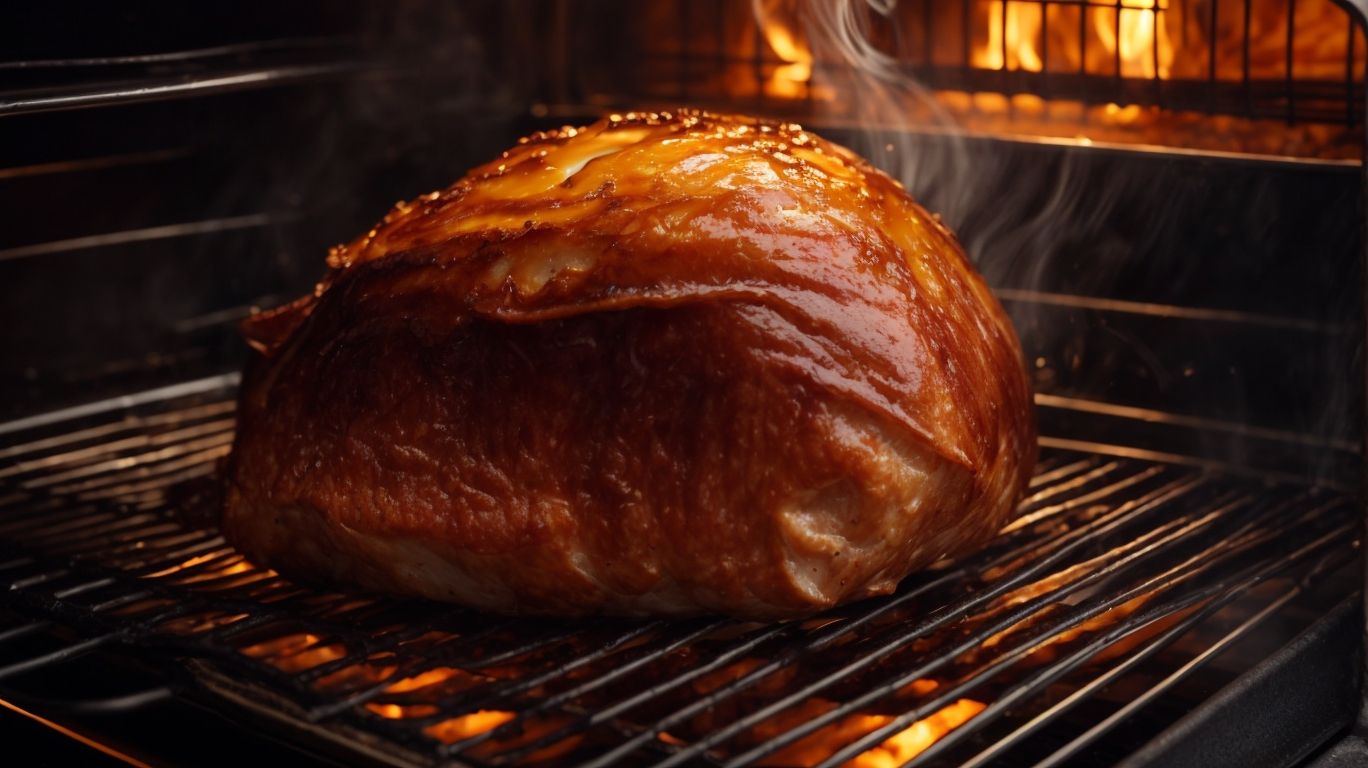
Credits: Poormet.Com – Stephen Thomas
Determining when ham is cooked involves checking the internal temperature, observing color changes, and assessing the texture for the desired doneness.
Regarding the internal temperature of ham, the recommended reading for cooked ham is usually around 145°F, ensuring that it is both safe to eat and retains its juiciness. A visual cue that the ham is adequately cooked is a slight browning of the outer layer, indicating caramelization. Texture-wise, a properly cooked ham will feel firm yet tender, with the fat slightly rendering and adding flavor. It’s essential to avoid overcooking, as this can result in dryness and toughness.
Internal Temperature
Using a thermometer to measure the internal temperature of ham is crucial for ensuring that it reaches the recommended degree of doneness for safe consumption.
When cooking ham, especially large cuts, relying solely on visual cues like color can be misleading. A thermometer provides accurate insights into the internal temperature, ensuring both safety and optimal taste. For cooked ham, the internal temperature should reach a minimum of 145°F (62.8°C) as recommended by the USDA. This ensures that harmful bacteria like salmonella and E. coli are destroyed, preventing foodborne illnesses. By utilizing a thermometer, you can confidently navigate the fine line between undercooking, which poses health risks, and overcooking, resulting in dry, tough meat.
Color and Texture
Evaluating the color and texture of ham helps in determining its doneness, ensuring that the meat is tender and moist without being overcooked or underdone.
When assessing the color of cooked ham, look for a pinkish hue that is uniform throughout the meat, indicating thorough cooking. Avoid any areas that appear raw or translucent as this suggests undercooking. Pay attention to the outer crust, which should have a crisp golden-brown appearance for optimal flavor.
Texture-wise, a well-cooked ham should feel tender and juicy when prodded gently with a fork. Overcooking can result in a dry, tough texture, while undercooking will leave the meat chewy and raw.
Serving Suggestions for Ham
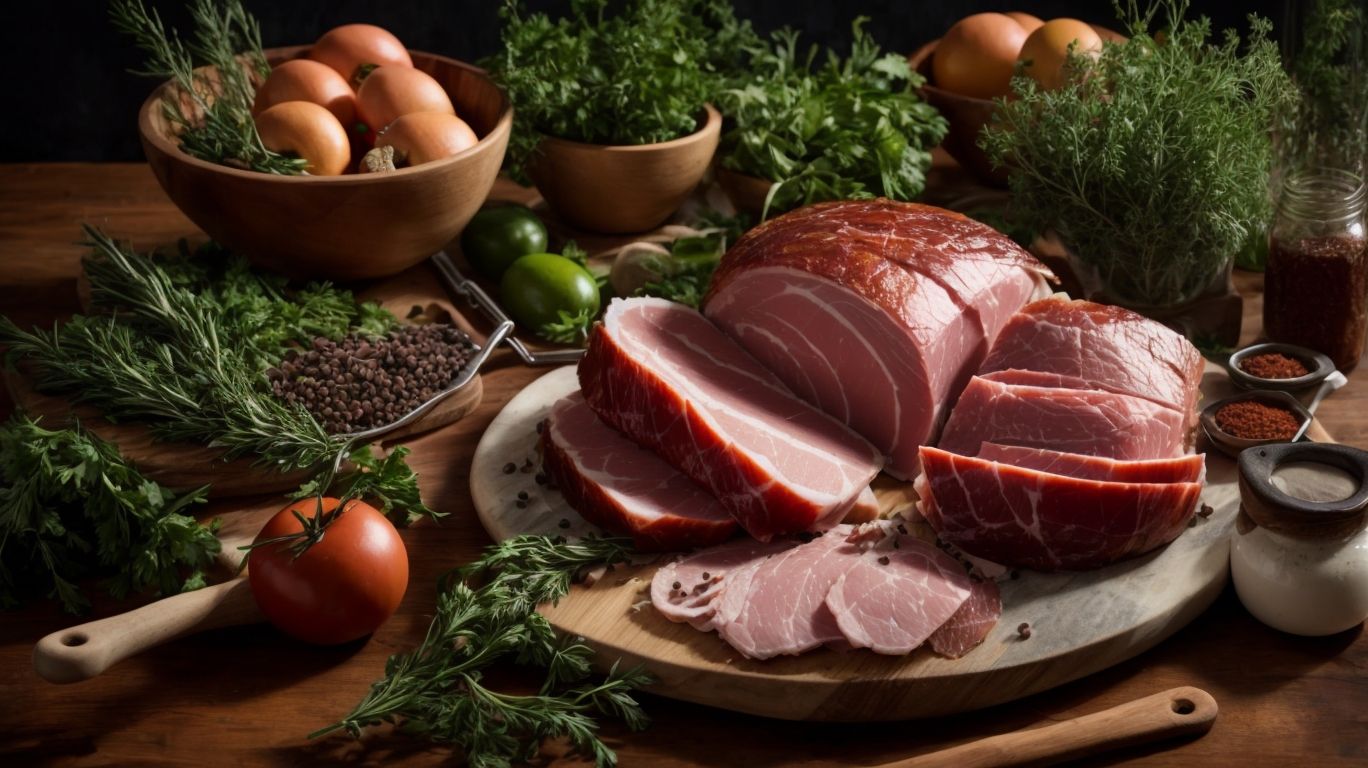
Credits: Poormet.Com – Timothy Hill
Serving ham opens up a world of possibilities, from classic side dishes to creative leftover recipes like ham and bean soup, making it a versatile choice for special occasions.
For a classic pairing with ham, consider serving it with scalloped potatoes or glazed carrots to complement the savory flavors. If you’re looking to spice things up, try a side of pineapple salsa or roasted Brussels sprouts for a modern twist. Leftover ham can be transformed into delicious dishes like ham and cheese quiche or ham fried rice, perfect for a quick and satisfying meal. To elevate your special occasions, consider serving a spiral-sliced ham with a cranberry glaze or a honey mustard sauce for an added burst of flavor.
Side Dishes to Serve with Ham
Pairing ham with complementary side dishes like roast chicken, carving platters, and beautifully arranged trays elevates the dining experience, especially during festive holidays.
When serving ham, consider incorporating seasonal fruits and vegetables to balance the flavors and add freshness to the meal. Roasted root vegetables, such as carrots, parsnips, and sweet potatoes, make wonderful accompaniments. You can also include a selection of pickles, chutneys, and mustards to offer a variety of flavors that complement the rich taste of the ham.
To enhance the presentation, arrange your side dishes in elegant serving bowls and platters to create a visually appealing spread. For a festive touch, garnish your dishes with fresh herbs and edible flowers. Consider serving a selection of artisan bread and rolls to complete the meal.
Leftover Ham Recipe Ideas
Transforming leftover ham into enticing dishes like ham and bean soup in a crock-pot or incorporating it into bone-in ham recipes with unique flavors like cloves and scoring adds a new dimension to meal planning.
Introducing leftover ham to savory crock-pot soups infuses the dish with rich, smoky flavors that meld beautifully with creamy beans. Simmering the ingredients together allows the ham to impart its essence gradually, creating a soul-warming meal for chilly nights.
When embracing bone-in ham recipes, the ritual of scoring the meat and delicately adding whole cloves elevates the taste profile to a whole new level. The scoring not only enhances the glaze’s penetration but also makes for an eye-catching presentation on the serving table.
Tips for Cooking the Perfect Ham
Achieving the perfect ham involves mastering key tips like using a thermometer for temperature control, creating a sticky glaze for a golden finish, and ensuring juicy results that can be enjoyed as flavorful leftovers.
Regarding temperature management, it’s crucial to cook your ham at the right heat. Preheat your oven to the recommended temperature, typically around 325°F, ensuring even cooking throughout. For a delightful texture, aim for a slightly crispy exterior while maintaining a succulent interior; this balance is key to a mouthwatering ham.
- To enhance the flavor profile of your ham, consider experimenting with a variety of glazes. A classic honey glaze or a combination of brown sugar and mustard can add a depth of flavor that complements the meat perfectly.
- For leftovers, don’t let anything go to waste. Chop up leftover ham to add to omelets, salads, or sandwiches for an added punch of flavor. You can also utilize the bone to make a savory broth for soups or stews.
Frequently Asked Questions
How to Cook Ham?
Cooking ham can seem intimidating, but with the right techniques, it’s actually quite simple. Here are some common questions and answers to help you cook the perfect ham.
What is the best way to cook ham?
The best way to cook ham is to bake it in the oven. This method allows the ham to cook evenly and develop a crispy crust while staying juicy on the inside. You can also try grilling or slow cooking for a different flavor profile.
Should I glaze my ham?
Glazing ham is a personal preference, but it can add a delicious sweet and savory crust to your ham. You can use a variety of glazes, such as honey mustard, brown sugar, or fruit preserves. Just be sure to apply the glaze in the last 30 minutes of cooking to prevent burning.
How do I know when my ham is cooked?
The best way to ensure your ham is cooked to perfection is by using a meat thermometer. The internal temperature of a fully cooked ham should be 145°F. If you don’t have a thermometer, you can also check for doneness by piercing the thickest part of the ham with a knife. The juices should run clear, not pink.
Do I need to baste my ham while cooking?
Basting is not necessary, but it can add extra flavor and moisture to your ham. If you choose to baste, do so every 20-30 minutes with the pan drippings or your chosen glaze.
How long should I cook my ham?
The cooking time for ham will depend on the size and type of ham you are using. As a general rule, cook ham for 15 minutes per pound at 325°F. Use a meat thermometer to ensure it reaches an internal temperature of 145°F before removing it from the oven.
Can I freeze leftover ham?
Yes, you can freeze leftover ham for up to 2 months. Slice or dice the ham and store it in an airtight container or freezer bag. Thaw it in the refrigerator before reheating, either in the oven or on the stovetop.

